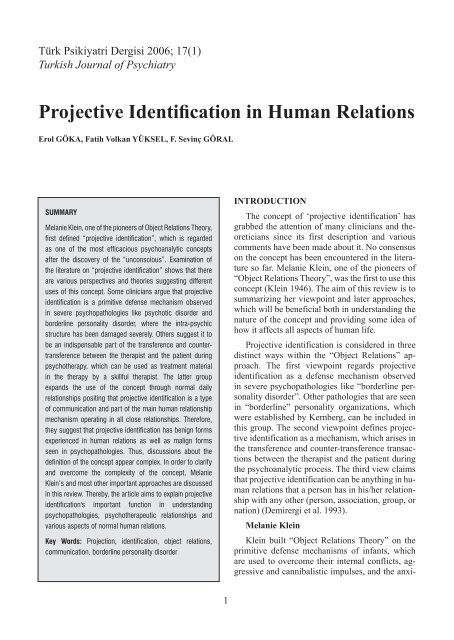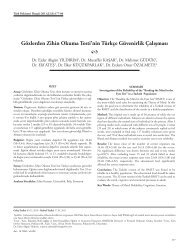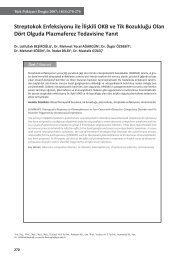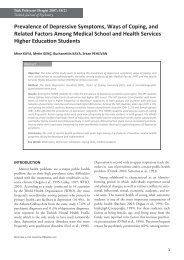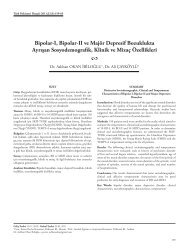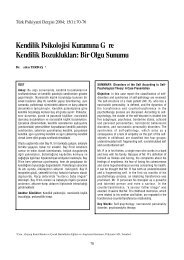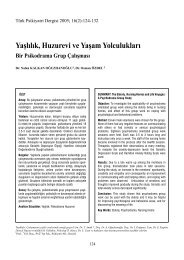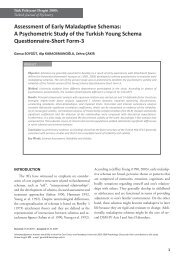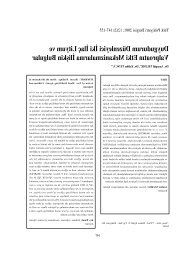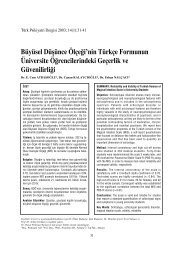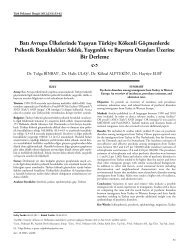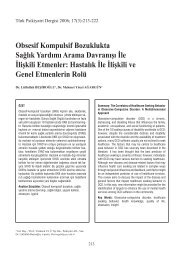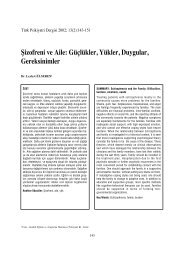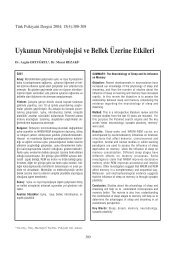Projective Identification in Human Relations - Türk Psikiyatri Dergisi
Projective Identification in Human Relations - Türk Psikiyatri Dergisi
Projective Identification in Human Relations - Türk Psikiyatri Dergisi
You also want an ePaper? Increase the reach of your titles
YUMPU automatically turns print PDFs into web optimized ePapers that Google loves.
<strong>Türk</strong> <strong>Psikiyatri</strong> <strong>Dergisi</strong> 2006; 17(1)<br />
Turkish Journal of Psychiatry<br />
<strong>Projective</strong> <strong>Identification</strong> <strong>in</strong> <strong>Human</strong> <strong>Relations</strong><br />
Erol GÖKA, Fatih Volkan YÜKSEL, F. Sev<strong>in</strong>ç GÖRAL<br />
SUMMARY<br />
Melanie Kle<strong>in</strong>, one of the pioneers of Object <strong>Relations</strong> Theory,<br />
first def<strong>in</strong>ed “projective identification”, which is regarded<br />
as one of the most efficacious psychoanalytic concepts<br />
after the discovery of the “unconscious”. Exam<strong>in</strong>ation of<br />
the literature on “projective identification” shows that there<br />
are various perspectives and theories suggest<strong>in</strong>g different<br />
uses of this concept. Some cl<strong>in</strong>icians argue that projective<br />
identification is a primitive defense mechanism observed<br />
<strong>in</strong> severe psychopathologies like psychotic disorder and<br />
borderl<strong>in</strong>e personality disorder, where the <strong>in</strong>tra-psychic<br />
structure has been damaged severely. Others suggest it to<br />
be an <strong>in</strong>dispensable part of the transference and countertransference<br />
between the therapist and the patient dur<strong>in</strong>g<br />
psychotherapy, which can be used as treatment material<br />
<strong>in</strong> the therapy by a skillful therapist. The latter group<br />
expands the use of the concept through normal daily<br />
relationships posit<strong>in</strong>g that projective identification is a type<br />
of communication and part of the ma<strong>in</strong> human relationship<br />
mechanism operat<strong>in</strong>g <strong>in</strong> all close relationships. Therefore,<br />
they suggest that projective identification has benign forms<br />
experienced <strong>in</strong> human relations as well as malign forms<br />
seen <strong>in</strong> psychopathologies. Thus, discussions about the<br />
def<strong>in</strong>ition of the concept appear complex. In order to clarify<br />
and overcome the complexity of the concept, Melanie<br />
Kle<strong>in</strong>’s and most other important approaches are discussed<br />
<strong>in</strong> this review. Thereby, the article aims to expla<strong>in</strong> projective<br />
identification's important function <strong>in</strong> understand<strong>in</strong>g<br />
psychopathologies, psychotherapeutic relationships and<br />
various aspects of normal human relations.<br />
Key Words: Projection, identification, object relations,<br />
communication, borderl<strong>in</strong>e personality disorder<br />
1<br />
INTRODUCTION<br />
The concept of ‘projective identification’ has<br />
grabbed the attention of many cl<strong>in</strong>icians and theoreticians<br />
s<strong>in</strong>ce its first description and various<br />
comments have been made about it. No consensus<br />
on the concept has been encountered <strong>in</strong> the literature<br />
so far. Melanie Kle<strong>in</strong>, one of the pioneers of<br />
“Object <strong>Relations</strong> Theory”, was the first to use this<br />
concept (Kle<strong>in</strong> 1946). The aim of this review is to<br />
summariz<strong>in</strong>g her viewpo<strong>in</strong>t and later approaches,<br />
which will be beneficial both <strong>in</strong> understand<strong>in</strong>g the<br />
nature of the concept and provid<strong>in</strong>g some idea of<br />
how it affects all aspects of human life.<br />
<strong>Projective</strong> identification is considered <strong>in</strong> three<br />
dist<strong>in</strong>ct ways with<strong>in</strong> the “Object <strong>Relations</strong>” approach.<br />
The first viewpo<strong>in</strong>t regards projective<br />
identification as a defense mechanism observed<br />
<strong>in</strong> severe psychopathologies like “borderl<strong>in</strong>e personality<br />
disorder”. Other pathologies that are seen<br />
<strong>in</strong> “borderl<strong>in</strong>e” personality organizations, which<br />
were established by Kernberg, can be <strong>in</strong>cluded <strong>in</strong><br />
this group. The second viewpo<strong>in</strong>t def<strong>in</strong>es projective<br />
identification as a mechanism, which arises <strong>in</strong><br />
the transference and counter-transference transactions<br />
between the therapist and the patient dur<strong>in</strong>g<br />
the psychoanalytic process. The third view claims<br />
that projective identification can be anyth<strong>in</strong>g <strong>in</strong> human<br />
relations that a person has <strong>in</strong> his/her relationship<br />
with any other (person, association, group, or<br />
nation) (Demirergi et al. 1993).<br />
Melanie Kle<strong>in</strong><br />
Kle<strong>in</strong> built “Object <strong>Relations</strong> Theory” on the<br />
primitive defense mechanisms of <strong>in</strong>fants, which<br />
are used to overcome their <strong>in</strong>ternal conflicts, aggressive<br />
and cannibalistic impulses, and the anxi-
eties of be<strong>in</strong>g subjected to damage or destruction.<br />
In her concept, she declares that <strong>in</strong>fants pass from<br />
a “paranoid-schizoid position” and a “depressive<br />
position”, respectively. The “position” here should<br />
be considered as a “state of ego organization that<br />
has its own anxieties, defense mechanisms and <strong>in</strong>ternal<br />
object relations” rather than a developmental<br />
phase (Alford 1989). The basic motivation <strong>in</strong><br />
these two positions is derived from the aggressive<br />
impulse. The <strong>in</strong>fant experiences objects as “part<br />
object”. The first part object for the <strong>in</strong>fant is the<br />
mother’s breast, which fills the largest part of the<br />
baby’s liv<strong>in</strong>g environment, and it actually forms a<br />
place <strong>in</strong> which the images that fill the imag<strong>in</strong>ary<br />
world for his/her aggressiveness and other impulses<br />
are stored. In order to decrease anxiety, an<br />
<strong>in</strong>fant <strong>in</strong> the paranoid-schizoid position tries to be<br />
purified from them by reflect<strong>in</strong>g the aggressiveness<br />
and bad aspects <strong>in</strong>side to the mother, that is<br />
the breast. In this position, mother is totally “bad”.<br />
Later, <strong>in</strong> Kle<strong>in</strong>'s depressive position, as the <strong>in</strong>fant<br />
develops other relations, he succeeds <strong>in</strong> see<strong>in</strong>g<br />
him/herself and the mother as the sum of the<br />
“good” and “bad”, and he/she feels guilty for not<br />
recogniz<strong>in</strong>g the good aspects of the mother <strong>in</strong> the<br />
past.<br />
Kle<strong>in</strong> stated that the <strong>in</strong>fant later <strong>in</strong>ternalizes<br />
the aggressive parts and impulses, which were<br />
transferred to the mother before. Similarly, any<br />
defecation of the <strong>in</strong>fant is related to the sole psychological<br />
figure, the mother. Dur<strong>in</strong>g defecation,<br />
the <strong>in</strong>fant actually discharges his/her bad part, the<br />
feces, to the mother. Here works the most primitive<br />
mechanism of “projection”; the baby projects<br />
the aggressive aspects (that he/she does not want<br />
for himself/herself) to the mother. Dur<strong>in</strong>g this period<br />
of <strong>in</strong>fancy, the breast is perceived as an extension<br />
of the mother and the mother is regarded<br />
as be<strong>in</strong>g formed by the whole breast. Decreas<strong>in</strong>g<br />
anxiety is a vital problem for the <strong>in</strong>fant who goes<br />
between suck<strong>in</strong>g the breast and empty<strong>in</strong>g it, and<br />
then discharg<strong>in</strong>g the dangerous, unwanted parts<br />
to the mother. The mother/breast is the <strong>in</strong>strument<br />
that provides anxiety reduction.<br />
Kle<strong>in</strong> declared that the basic mechanism related<br />
to the “projection” is the mechanism of “splitt<strong>in</strong>g”.<br />
The <strong>in</strong>fant keeps the psychological images<br />
of “good mother” and “bad mother” and “good<br />
self” and “bad self” separately, which means that<br />
the baby is splitt<strong>in</strong>g. As the experiences with the<br />
mother <strong>in</strong>crease (as long as there are no problems<br />
2<br />
<strong>in</strong> this relationship due to <strong>in</strong>sufficient or extreme<br />
parent<strong>in</strong>g of the mother), this splitt<strong>in</strong>g evolves towards<br />
the perception of ‘mother and self with both<br />
good and bad aspects’. The basic motivator of this<br />
splitt<strong>in</strong>g defense that <strong>in</strong>fants develop with<strong>in</strong> the<br />
preoedipal period is to protect themselves from<br />
‘bad’ aspects of the ego and object. In preoedipal<br />
stage, the pieces that are tried to be kept separately<br />
by the <strong>in</strong>fant by means of splitt<strong>in</strong>g <strong>in</strong> the psychological<br />
device are projected onto the mother.<br />
Kle<strong>in</strong> stated that <strong>in</strong> projective identification,<br />
first the <strong>in</strong>fant projects “a piece” to the mother and<br />
then takes it back and identifies with it. The basic<br />
aim here is to govern and control the mother rather<br />
than escap<strong>in</strong>g from bad aspects and harm<strong>in</strong>g her.<br />
<strong>Projective</strong> identification from this po<strong>in</strong>t of view is<br />
actually a more primitive mechanism than “projection”;<br />
dur<strong>in</strong>g “projection”, the negative content of<br />
the <strong>in</strong>ner world is spewed onto someone else. In<br />
projective identification however, there is the aim<br />
of to control the behaviors of counterpart (Kle<strong>in</strong><br />
1952).<br />
As it can be seen, Kle<strong>in</strong>’s views depend on the<br />
events with<strong>in</strong> the <strong>in</strong>fant’s imag<strong>in</strong>ary world rather<br />
than a real mother-<strong>in</strong>fant relationship, and the aggressive<br />
impulse is extensively mentioned. That<br />
is what Kle<strong>in</strong> was criticized a lot for (Gabbard<br />
1990), however these critiques do not elim<strong>in</strong>ate<br />
the contribution of the mechanisms that Kle<strong>in</strong> tried<br />
to def<strong>in</strong>e, particularly projective identification, <strong>in</strong><br />
which is present <strong>in</strong> all human relationships.<br />
Kle<strong>in</strong> perceived that the orig<strong>in</strong> of human behavior<br />
is <strong>in</strong> the relationship with mother, the fundamentals<br />
about the self are constructed with<strong>in</strong> the<br />
first years of life. When she began to observe this<br />
relationship, she claimed that aggressiveness and<br />
power relations govern the human <strong>in</strong>fant at the<br />
beg<strong>in</strong>n<strong>in</strong>g of its life. The aggressive <strong>in</strong>st<strong>in</strong>ct and<br />
the desire to control others to survive exist from<br />
the very beg<strong>in</strong>n<strong>in</strong>g of life and it is essential for<br />
the relationship with the mother. <strong>Projective</strong> identification<br />
is a description of the <strong>in</strong>fant attribut<strong>in</strong>g<br />
its own negative aspects and deficiencies to the<br />
mother and motivat<strong>in</strong>g her to satisfy these needs,<br />
<strong>in</strong> other words, to control her.<br />
Bion and Kernberg<br />
Wilfred R. Bion, the English group analyst,<br />
exam<strong>in</strong>ed the projective identification concept <strong>in</strong><br />
the therapist-patient relationship (Bion 1959). Ac-
cord<strong>in</strong>g to Bion, projective identification can be<br />
used as an <strong>in</strong>strument of therapy by a therapist<br />
who understands the mechanism <strong>in</strong> detail. The<br />
therapist perceives that he plays an <strong>in</strong>strumental<br />
role <strong>in</strong> the relationship with the patient, that the<br />
patient projects his/her bad parts onto the therapist,<br />
who accepts what is projected without any<br />
resistance, conta<strong>in</strong>s and gives back them after they<br />
are modified; this allows the patient to receive his/<br />
her own projections changed and processed. Dur<strong>in</strong>g<br />
psychotherapy, <strong>in</strong> order to <strong>in</strong>tegrate all his/her<br />
bad aspects, and to develop, the patient proceeds<br />
from the paranoid-schizoid position to the depressive<br />
position; the real change arises at this po<strong>in</strong>t.<br />
The patient actually reproduces the patterns that<br />
he always repeats <strong>in</strong> his daily life by project<strong>in</strong>g the<br />
“bad” parts <strong>in</strong>side him/herself to the therapist and<br />
becom<strong>in</strong>g purified from them. However, contrary<br />
to the people <strong>in</strong> daily life, because the therapist<br />
does not project these projections back (but holds<br />
onto them <strong>in</strong>), the patient does not <strong>in</strong>ternalize these<br />
“bad” projections. Thus, the patient <strong>in</strong>ternalizes the<br />
processed and more positive projections <strong>in</strong>stead of<br />
the “bad” projections. The importance of Bion’s<br />
approach is its recognition and correction of projective<br />
identifications, which plays an important<br />
role <strong>in</strong> human relations.<br />
The first serious critiques of Melanie Kle<strong>in</strong>'s<br />
theory came from another Object <strong>Relations</strong> theoretician,<br />
Otto Kernberg. However, as all Object <strong>Relations</strong><br />
theoreticians, Kernberg is also her follower.<br />
Like Kle<strong>in</strong>, he also observed human relationships,<br />
not the psychological <strong>in</strong>st<strong>in</strong>cts. Kernberg is not<br />
<strong>in</strong>terested <strong>in</strong> the aspect of projective identification<br />
that provides opportunity to understand the<br />
nature of human relations; he focuses on the representations<br />
of the mechanism <strong>in</strong> severe cl<strong>in</strong>ical<br />
phenomena, which is called borderl<strong>in</strong>e personality<br />
organization. Accord<strong>in</strong>g to Kernberg, projective<br />
identification is a primitive defense mechanism,<br />
thus it can be observed only <strong>in</strong> the most severe<br />
psychological disorders such as borderl<strong>in</strong>e personality<br />
disorders or psychotic conditions <strong>in</strong> which<br />
patients have an overwhelm<strong>in</strong>g need to project the<br />
bad objects (object representation) and self-representations<br />
of themselves (Kernberg 1967).<br />
Kernberg agrees with Kle<strong>in</strong> <strong>in</strong> that projective<br />
identification is a more primitive defense mechanism<br />
than projection. However, he claims that the<br />
reason is not related to the motivation of projective<br />
identification on sett<strong>in</strong>g dom<strong>in</strong>ance, as Kle<strong>in</strong><br />
3<br />
suggests, but with the <strong>in</strong>fant’s position of not yet<br />
be<strong>in</strong>g separated from the mother and to <strong>in</strong>dividual<br />
borders, which are not well def<strong>in</strong>ed. He th<strong>in</strong>ks that<br />
empathy has an essential role <strong>in</strong> the process<strong>in</strong>g of<br />
projective identification. In order to perform projection,<br />
the separation of mother and <strong>in</strong>fant should<br />
be completed. <strong>Projective</strong> identification is a primitive<br />
defense mechanism because of the fact that<br />
it arises <strong>in</strong> a period <strong>in</strong> which the <strong>in</strong>fant is not yet<br />
separated from the mother and cannot project.<br />
The empathy that Kernberg mentions here is not<br />
healthy empathy that provides reciprocal comprehension<br />
<strong>in</strong> human relations, but the more primitive<br />
one, the empathy that is the result from not be<strong>in</strong>g<br />
separated and has a negative mean<strong>in</strong>g. From this<br />
po<strong>in</strong>t of view, with<strong>in</strong> the period that the <strong>in</strong>fant cannot<br />
differentiate from the mother, it <strong>in</strong>ternalizes<br />
everyth<strong>in</strong>g that belongs to the <strong>in</strong>ner world of the<br />
mother with empathy; that is the basis of projective<br />
identification. In this period, because the <strong>in</strong>fant<br />
easily <strong>in</strong>ternalizes the psychological system of<br />
the mother and there is no other mechanism to protect<br />
him from dangerous psychological events, the<br />
<strong>in</strong>fant is exposed to all the destructive effects of<br />
the mother’s <strong>in</strong>ternal world. Kernberg claims that<br />
adults, who also do not have well-def<strong>in</strong>ed self-borders,<br />
use the same defense mechanisms <strong>in</strong> human<br />
relations as <strong>in</strong> <strong>in</strong>fancy. If the <strong>in</strong>dividual borders are<br />
not well def<strong>in</strong>ed <strong>in</strong> a relationship, but <strong>in</strong>term<strong>in</strong>gled,<br />
<strong>in</strong>teractions <strong>in</strong> this relationship are basically<br />
projective identification. However, Kernberg later<br />
announced that projective identification might<br />
even be possible between <strong>in</strong>dividuals who have<br />
well-def<strong>in</strong>ed borders (Kernberg 1987). Kernberg’s<br />
explanation of projective identification and its dependence<br />
upon empathy have important connotations<br />
for understand<strong>in</strong>g human relationships and<br />
for comprehend<strong>in</strong>g the formation of self and identity.<br />
<strong>Projective</strong> identification, negative or positive,<br />
is a mechanism that arises <strong>in</strong> our relationships with<br />
objects to which we give importance, are close to<br />
us, and that we feel familiar with. Kernberg’s contribution<br />
is important <strong>in</strong> understand<strong>in</strong>g the appearance<br />
of more destructive emotional connections <strong>in</strong><br />
close relationships and the destructive, negative,<br />
and alienat<strong>in</strong>g universal feel<strong>in</strong>gs between groups<br />
that live close to each other with<strong>in</strong> the formation<br />
period of group (and community) identities.<br />
Those Who Consider <strong>Projective</strong><br />
<strong>Identification</strong> A Form Of “Communication”<br />
Porder considers projective identification not
only as a defense mechanism but also as a mechanism<br />
that exists <strong>in</strong> usual human relationships. Accord<strong>in</strong>g<br />
to him, projective identification can be<br />
regarded as the cont<strong>in</strong>uous repetition of the <strong>in</strong>teraction<br />
between the parent or caregiver and the <strong>in</strong>fant<br />
(Porder 1987). The mother actually wants or<br />
forces the <strong>in</strong>fant to behave <strong>in</strong> a certa<strong>in</strong> way, and<br />
the <strong>in</strong>fant learns to control others from his mother.<br />
Here, the mother is the first object that cares for<br />
the child. If the child has difficulties <strong>in</strong> his life,<br />
which are beyond its ability to solve, by revers<strong>in</strong>g<br />
the roles <strong>in</strong> the mother-<strong>in</strong>fant relationship, he/she<br />
beg<strong>in</strong>s to use the same behaviors that the mother<br />
uses to control the others, impersonat<strong>in</strong>g her role,<br />
because the <strong>in</strong>fant has limited abilities and knowledge<br />
to survive. This usual mechanism for children<br />
may sometimes come up <strong>in</strong> the adulthood.<br />
Porder provides psychotherapeutic examples <strong>in</strong><br />
order to prove his hypothesis. The patient, who<br />
is <strong>in</strong> a transference relationship with the analyst,<br />
perceives him/her as a powerful parent (mother).<br />
However, when projective identification comes<br />
<strong>in</strong>to the relationship, this perception is reversed;<br />
the analyst becomes helpless, weak, the bad child,<br />
and the patient becomes a powerful, though, and<br />
critical parent (mother). In such a case, the patient<br />
beg<strong>in</strong>s to behave towards his therapist <strong>in</strong> that same<br />
way that his parents did towards him. Accord<strong>in</strong>g<br />
to Porder, here there is not the projection of the<br />
patient’s emotions to analyst, as it is <strong>in</strong> any transference<br />
relationship, but an attempt by the patient<br />
to get the analyst to act <strong>in</strong> a particular way dur<strong>in</strong>g<br />
the session. <strong>Projective</strong> identification can arise <strong>in</strong> all<br />
stages of psychosexual development and provides<br />
adaptation and needs of superego. In other words,<br />
<strong>in</strong> projective identification, there is no other process<br />
except the effort of us<strong>in</strong>g the defenses, which<br />
are used by the parents and are usually pathological,<br />
and the repetition of this effort <strong>in</strong> adulthood.<br />
In normal relationships, behaviors that arise <strong>in</strong> a<br />
person as the enforcement of another to behave <strong>in</strong><br />
a certa<strong>in</strong> way, projective identification is the implantation<br />
of the <strong>in</strong>dividual’s <strong>in</strong>ternal parts <strong>in</strong>to the<br />
"other's" psychological system <strong>in</strong> an effort to control<br />
him/her by exist<strong>in</strong>g as a part of the "other".<br />
Z<strong>in</strong>ner and Shapiro (1972) enlarged projective<br />
identification toward family and marriage therapy.<br />
Like Porder, they also consider projective identification<br />
not as a primitive defense mechanism, but<br />
as a mechanism, which exists <strong>in</strong> ord<strong>in</strong>ary daily<br />
life. Accord<strong>in</strong>g to them, these defensive process-<br />
4<br />
es, which are regarded as pathological, are normal;<br />
moreover, relations, which are experienced<br />
<strong>in</strong> romantic relationships, are actually projective<br />
identification. <strong>Projective</strong> identifications are cont<strong>in</strong>uously<br />
experienced between married couples<br />
(Scharff and Scharff 1997; Zosky 2003). For <strong>in</strong>stance,<br />
a husband <strong>in</strong>serts and projects the passivity<br />
and weakness that he does not want for himself<br />
to his wife and can keep his aggressive and<br />
competitive aspects of himself. This, <strong>in</strong> turn, is<br />
an ideal position for the woman who can provide<br />
the image of the passive, desperate, dependent <strong>in</strong>dividual<br />
<strong>in</strong> need of protection, by project<strong>in</strong>g aggressive<br />
and competitive features to the husband.<br />
<strong>Projective</strong> identifications between the partners, <strong>in</strong><br />
this respect, have a supportive and complementary<br />
feature. Partners stay <strong>in</strong> the relationship by accept<strong>in</strong>g<br />
these projective identifications. The same feature<br />
is consistent for the relationship between the<br />
child and the parent and it is usually the child who<br />
accepts the projections. Children easily accept the<br />
projections, mostly because of the fear of los<strong>in</strong>g<br />
the parent’s love.<br />
Accord<strong>in</strong>g to Tom Ma<strong>in</strong> (1975), <strong>in</strong> projective<br />
identification “the other” is forced to feel the aggressive<br />
features and impulses, which are projected<br />
by the projector, and are actually not familiar to<br />
"the other". Therefore "the other" may feel bizarre<br />
and disturbed, and may feel anger towards the projector.<br />
However, aga<strong>in</strong>st the weakness and fear of<br />
the projector, it can become quite difficult to resist<br />
the superiority and aggressive power that are be<strong>in</strong>g<br />
projected onto "the other". Such disturbances<br />
more or less affect the relationships of all couples.<br />
A woman, for <strong>in</strong>stance, projects her frighten<strong>in</strong>g,<br />
unwanted, aggressive, and controll<strong>in</strong>g aspects to<br />
her husband and then gets afraid of him and respects<br />
to him. On the other hand, the husband may<br />
feel aggressive and controll<strong>in</strong>g due to the forcefully<br />
<strong>in</strong>stalled projections of his wife. Moreover,<br />
he may despise and deny certa<strong>in</strong> aspects of his<br />
own personality due to personal reasons and project<br />
these to his wife, so he may also despise her.<br />
Thus, his wife may become <strong>in</strong>stalled not only with<br />
her own attributes but also with her husband's.<br />
Certa<strong>in</strong> couples live <strong>in</strong> systems <strong>in</strong> which the connected<br />
projection imag<strong>in</strong>ations are so dom<strong>in</strong>ant<br />
that each one experiences be<strong>in</strong>g married to a projected,<br />
unwanted, divided self, <strong>in</strong>stead of another<br />
dist<strong>in</strong>ct <strong>in</strong>dividual. However, a dom<strong>in</strong>ant and rude<br />
husband and a reluctant and respectful wife may
e extremely unhappy with themselves and with<br />
each other, although the marriage is stable because<br />
one of the partners needs the other for narcissistic<br />
pathological goals. In other words, forced projection<br />
experiences, particularly projective identification,<br />
are present due to the <strong>in</strong>ter-relationship between<br />
both <strong>in</strong>dividuals. “The other” (usually the<br />
person <strong>in</strong> close relation) is more or less always<br />
found <strong>in</strong> the projective identification and is affected<br />
by the process. Sometimes <strong>in</strong> relationships,<br />
the bonds, which are formed by projective identifications,<br />
create such a node mode that disorders<br />
with<strong>in</strong> the space between the <strong>in</strong>dividuals, due to<br />
common personality depletions and occupations,<br />
may be seen.<br />
The major contribution of those who consider<br />
projective identification a form of communication<br />
<strong>in</strong> human relationships is their def<strong>in</strong>ition of projective<br />
identification as a process that is at work <strong>in</strong> all<br />
human relationships and free<strong>in</strong>g the concept from<br />
the conf<strong>in</strong>es of severe psychopathologies.<br />
Ogden’s Model<br />
Recent studies on projective identification are<br />
based on Ogden’s model rather than Kle<strong>in</strong>’s, because<br />
Ogden developed a model on which a consensus<br />
can be arrived at by revis<strong>in</strong>g all of the theories<br />
that were summarized above. Ogden surmised<br />
that projective identification could be either normal<br />
or pathological. He concluded that the pathological<br />
form of projective identification can be observed<br />
<strong>in</strong> severe personality disorders and psychoses, and<br />
the material, which is projected here, is self-representations.<br />
The more healthy projective identifications,<br />
which can be observed <strong>in</strong> the neurosis and<br />
daily lives of normal <strong>in</strong>dividuals, are simply the<br />
projections of object representations (Ogden 1979;<br />
Ogden 1982). In his model, the projective identification<br />
is expla<strong>in</strong>ed <strong>in</strong> three successive steps. These<br />
are the projection, <strong>in</strong>teraction between <strong>in</strong>dividuals,<br />
and re-<strong>in</strong>ternalization of the projection, which are<br />
described as follows:<br />
1. Projection: the person projects the part of him/<br />
herself that he/she wants to discard. The reason for<br />
this is the possibility that this part can destroy him/<br />
her. The self is a composite that is formed by the<br />
perception about one's self and the representations<br />
about the self and an object. If the psychic apparatus<br />
has not digested and <strong>in</strong>ternalized, although<br />
it conta<strong>in</strong>s these self and object representations, it<br />
projects these parts. Otherwise, these undigested<br />
5<br />
bad parts cause anxiety when they rema<strong>in</strong> <strong>in</strong>side.<br />
Thus, an attempt is made to elim<strong>in</strong>ate the anxiety<br />
through projection. As mentioned above, the<br />
projection of self-representations is considered a<br />
more primitive process than projection of object<br />
representations and arises mostly <strong>in</strong> borderl<strong>in</strong>e<br />
and psychotic disorders. The projection of object<br />
representations, <strong>in</strong> general, is a feature of transference;<br />
it can be observed <strong>in</strong> all human relationships,<br />
dur<strong>in</strong>g psychotherapy, and neurosis.<br />
2. Interaction between persons: an <strong>in</strong>dividual<br />
tries to affect another (or object) and change it as<br />
he/she sees fit. The message beneath the surface of<br />
this <strong>in</strong>teraction is, “you are what I told you to be,<br />
accept it”. The purpose is for "the other" to th<strong>in</strong>k,<br />
act, and feel <strong>in</strong> accordance with the projected parts<br />
of the projector. This is achieved <strong>in</strong> the <strong>in</strong>terpersonal<br />
space rather than the <strong>in</strong>trapsychic one. This<br />
sought after control is the basis of the projective<br />
identification between persons and groups, and<br />
without this step related to the <strong>in</strong>teraction between<br />
persons, projective identification is not achieved.<br />
The acceptance of the fact that the projective identification<br />
has an <strong>in</strong>teractive nature, because of this<br />
step turns it <strong>in</strong>to not only a defense mechanism but<br />
also a communication pattern (Jureid<strong>in</strong>i 1990).<br />
3. Re<strong>in</strong>ternalization of the projection: the person<br />
who receives the projections, processes these<br />
and makes changes to them. Later, the person who<br />
projects, re<strong>in</strong>ternalizes and identifies with these<br />
processed parts. The possibility of discard<strong>in</strong>g from<br />
these parts and provid<strong>in</strong>g a change <strong>in</strong> a different<br />
way decrease as identification realizes. If the person<br />
who receives the projection has a quite different<br />
personality than the one who projects, the<br />
projected material is changed basically. Accord<strong>in</strong>g<br />
to Ogden, these processed parts may be so different<br />
that the person may not need to discard them<br />
when re<strong>in</strong>ternalized. As we mentioned <strong>in</strong> the section<br />
about Bion, this step has great importance<br />
<strong>in</strong> psychotherapy, because the re<strong>in</strong>ternalization<br />
process can be changed <strong>in</strong>to a therapeutic change<br />
process with the help of appropriate <strong>in</strong>terventions<br />
by a knowledgeable therapist. Therefore, a patient<br />
may f<strong>in</strong>d new ways of cop<strong>in</strong>g with the thoughts<br />
and feel<strong>in</strong>gs that he/she wanted to discard (Goldste<strong>in</strong><br />
1991).<br />
Cashdan’s Therapy of Object <strong>Relations</strong><br />
Sheldon Cashdan <strong>in</strong>serted the term projective<br />
identification <strong>in</strong>to the communication concept by
tak<strong>in</strong>g Ogden’s model <strong>in</strong>to account, and develop<strong>in</strong>g<br />
his own object relations therapy approach,<br />
which is based on the projective identification<br />
concept (Cashdan 1988). After the substantial<br />
<strong>in</strong>terpersonal theoreticians who considered psychoanalysis<br />
related not only to sexual <strong>in</strong>st<strong>in</strong>cts,<br />
but also to the mother-<strong>in</strong>fant relationship, Cashdan<br />
claimed that similar dynamics are consistent<br />
<strong>in</strong> all human relationships, and it is necessary to<br />
regard projective identification <strong>in</strong> order to arrange<br />
and improve them. Accord<strong>in</strong>g to him, the determ<strong>in</strong>ative<br />
factor <strong>in</strong> projective identification is the<br />
<strong>in</strong>duction of others to act <strong>in</strong> accordance with what<br />
is projected. A person <strong>in</strong>serts his/her own parts <strong>in</strong>to<br />
"the other", regard<strong>in</strong>g the sensations and structures<br />
of his/her own psychological system, which are<br />
formed by experiences. The receiver of the projections<br />
is forced to accept and act <strong>in</strong> accordance<br />
with these parts. The theoretician <strong>in</strong>vestigates how<br />
people who are exposed to projections become the<br />
target of such projections and allows the projector<br />
to force them to act accord<strong>in</strong>gly. Cashdan po<strong>in</strong>ts<br />
out the importance of characteristics of the recipient<br />
<strong>in</strong> the process of projective identification, and<br />
made his basic contribution by show<strong>in</strong>g that a<br />
person <strong>in</strong>tuitionally knows which projections the<br />
recipient will accept and develops the necessary<br />
approaches.<br />
Accord<strong>in</strong>g to theoreticians, there are two<br />
types of communication <strong>in</strong> human<br />
relationships (Ruesch 1980):<br />
a. Overt Communication: it is direct verbal<br />
communication. Everybody understands almost<br />
100% of what is communicated. Such communication<br />
is only possible <strong>in</strong> face-to-face relationships<br />
<strong>in</strong> which the choice of exam<strong>in</strong><strong>in</strong>g what is heard is<br />
possible with feedback and questions.<br />
b. Covert (Meta) Communication: the messages<br />
between people are not verbal; it arises depend<strong>in</strong>g<br />
on the quality of the feel<strong>in</strong>g and expression rather<br />
than the words used. Because of the fact that the<br />
mean<strong>in</strong>gs of the messages used <strong>in</strong> Covert (Meta)<br />
communication cannot be immediately considered<br />
by the receiver and there may be many comments<br />
on what is said, there may also be covert enforcement<br />
with<strong>in</strong> these messages at the same time.<br />
Accord<strong>in</strong>g to Cashdan, the first communication<br />
type forms the healthy aspect <strong>in</strong> <strong>in</strong>teractions. Covert<br />
(Meta) communication, however, forms the<br />
basis of projective identifications by br<strong>in</strong>g<strong>in</strong>g the<br />
6<br />
secret enforcements to human relations. Accord<strong>in</strong>g<br />
to Cashdan, most of the projective identifications<br />
are the traces of broken object relations from with<strong>in</strong><br />
the early childhood period and are the traces<br />
of mother-father-child relationship. The motherfather-child<br />
relationship at the beg<strong>in</strong>n<strong>in</strong>g of life<br />
works by Covert (Meta) communication, because<br />
the child is not capable of verbal communication at<br />
the time. The child perceives a secret message <strong>in</strong><br />
his mother’s attitudes that she will not give importance<br />
to, or love or care for him/her unless he/she<br />
behaves accord<strong>in</strong>g to her expectations. He claims<br />
that the mother gives the message to her child that,<br />
“if you behave this way, I will not do this to you”<br />
and the child grows up receiv<strong>in</strong>g these messages.<br />
Later the <strong>in</strong>fant takes over this aspect of mother<strong>in</strong>fant<br />
communication and cont<strong>in</strong>ues furthermore.<br />
However, this pattern may change as the result of<br />
consecutive relationship experiences.<br />
Object <strong>Relations</strong> Therapy, accord<strong>in</strong>g to Cashdan,<br />
is based on attempts to change the projective<br />
identifications <strong>in</strong>to healthy relationship forms<br />
by us<strong>in</strong>g the patient-therapist relationship, which<br />
can be considered a repetition of the mother-father-child<br />
relationship. Because object relations<br />
<strong>in</strong> <strong>in</strong>fancy beg<strong>in</strong> to form with representations and<br />
imag<strong>in</strong>ation before the use of language is acquired,<br />
the processes cont<strong>in</strong>ues to work <strong>in</strong> the imag<strong>in</strong>ary<br />
dimension after the use of language is acquired,<br />
even <strong>in</strong> adulthood. In order to m<strong>in</strong>imize this, direct<br />
verbal communication is attempted dur<strong>in</strong>g therapy.<br />
If covert communications are experienced dur<strong>in</strong>g<br />
therapy, as <strong>in</strong> real life, it h<strong>in</strong>ders the therapeutic<br />
process.<br />
Cashdan described 4 basic types of projective<br />
identification, which come from pathological object<br />
relations <strong>in</strong> the early periods of life. These<br />
are dependence, power, sexuality, and <strong>in</strong>gratiation<br />
projective identifications, which are described as<br />
follows:<br />
1. Dependence projective identification: the<br />
aim <strong>in</strong> this projective identification type is to force<br />
"the other" to help. Such persons usually look for<br />
someone else to offer help and support for themselves,<br />
even <strong>in</strong> situations that they have to decide<br />
themselves. Despite the <strong>in</strong>nocent appearance of<br />
these calls for help, the underly<strong>in</strong>g message on<br />
the covert communicative level is, “I cannot live<br />
without you”. Such persons use expressions like,<br />
“what do you th<strong>in</strong>k?”, “what should I do?”, “can
you help me?”, and “I do not th<strong>in</strong>k that I can do<br />
it alone”. Actually, most of the time they have the<br />
power to overcome all these problems and most<br />
of them are clever persons. If these people cannot<br />
f<strong>in</strong>d "the other" to receive their projective identification<br />
or their wishes to satisfy, their dependence<br />
needs are denied by the others and as their anxiety<br />
<strong>in</strong>creases cry<strong>in</strong>g attacks, hysterical crises, severe<br />
depressions, and even suicidal tendencies may be<br />
encountered. Regard<strong>in</strong>g this aspect, the underly<strong>in</strong>g<br />
mechanism <strong>in</strong> many cases of depression, agoraphobia,<br />
and conversion disorder is projective<br />
identification.<br />
There is a strengthen<strong>in</strong>g of the dependence of a<br />
child for the mother <strong>in</strong> the covert communication<br />
of mothers who uses projective identification conta<strong>in</strong><strong>in</strong>g<br />
the message of, “the more you obey your<br />
mother’s orders, the more your mother loves you”.<br />
Thus, the determ<strong>in</strong>ative appearance <strong>in</strong> the motherfather-child<br />
relationship <strong>in</strong>hibits the <strong>in</strong>itiative of<br />
the child by unnecessary advice and guidance.<br />
2. Power projective identification: <strong>in</strong> essence,<br />
there is the desire of be<strong>in</strong>g dom<strong>in</strong>ant and to control<br />
others by mak<strong>in</strong>g the "other" feel <strong>in</strong>sufficient.<br />
Messages like, “do exactly what I say!”, “obey<br />
me!”, and “you cannot live without me!” are transferred<br />
to "the other" as covert communication.<br />
Here, there is the belief that the "other" cannot do<br />
anyth<strong>in</strong>g unless he/she behaves like the projector.<br />
Sexual discrim<strong>in</strong>ation may serve to support<strong>in</strong>g<br />
this projective identification. We encounter<br />
power projective identification <strong>in</strong> corporations<br />
as the dom<strong>in</strong>ant relationship type. The parents of<br />
<strong>in</strong>dividuals that use this projective identification,<br />
make the child feel that the parent cannot even<br />
give care, and actually it is the parent that needs<br />
to be cared for. Such cases are usually encountered<br />
<strong>in</strong> parents who are physically or mentally handicapped,<br />
or who have chronic or malign diseases, or<br />
who are alcoholic. Children who have such parents<br />
see themselves as unwanted children and they are<br />
cont<strong>in</strong>uously <strong>in</strong> fear of be<strong>in</strong>g abandoned. A precocious<br />
type of child is encountered frequently<br />
with such parents. A child’s personality is obliged<br />
to transform <strong>in</strong>to an adult image. This projective<br />
identification can be obta<strong>in</strong>ed imag<strong>in</strong>atively. The<br />
<strong>in</strong>fant who is afraid of be<strong>in</strong>g abandoned by his<br />
mother th<strong>in</strong>ks, <strong>in</strong> his imag<strong>in</strong>ation, that he controls<br />
its mother’s behaviors and with the help of dreams<br />
he/she lives as though he/she controls his mother.<br />
This, <strong>in</strong> turn, similarly leads to comprehension of<br />
7<br />
projective identification. Dependence projective<br />
identification is frequent <strong>in</strong> females, while power<br />
projective identification is frequent <strong>in</strong> males.<br />
3. Sexuality projective identification: the person<br />
who uses sexuality projective identification<br />
forces the "other" to provide erotic reactions. Messages<br />
with sexual content are projected as covert<br />
communication. Differ<strong>in</strong>g from those that have<br />
normal sexual, relationships <strong>in</strong> which there is<br />
sexuality projective identification, sexual function<br />
does not arise spontaneously and is not impulsive,<br />
and sexuality overshadows all other aspects of the<br />
relationship. This means that when sexuality disappears,<br />
the relationship ends. Sexuality projective<br />
identification is unique <strong>in</strong> that it depends upon<br />
the behaviors be<strong>in</strong>g highly valued by the child,<br />
rather than the restriction of them and usually arises<br />
from a mother-child relationship <strong>in</strong> which the<br />
message of, “you are desired as long as you make<br />
me feel excited and stimulate me” is given. The<br />
child learns that his communications that are coy<br />
and flirtatious, or that consist of sexuality are more<br />
valuable than the covert messages, which are not<br />
actually spelled.<br />
4. Ingratiation projective identifications: the<br />
person who uses <strong>in</strong>gratiation projective identification<br />
cont<strong>in</strong>uously shows self-denial <strong>in</strong> order to<br />
ga<strong>in</strong> the "other's" love. He <strong>in</strong>gratiates himself to<br />
the "other" by always putt<strong>in</strong>g himself <strong>in</strong> a secondary<br />
position. However, <strong>in</strong> <strong>in</strong>stances of disappo<strong>in</strong>tment,<br />
this usually transforms <strong>in</strong>to tell<strong>in</strong>g off or<br />
call<strong>in</strong>g the "other" to account for what he has or<br />
has not done. Messages such as, “you did not appreciate<br />
the value of what I did for you!”, and “I<br />
sacrificed myself for you!” are found <strong>in</strong> the covert<br />
communication. The persons, who are exposed to<br />
<strong>in</strong>gratiation projective identification, on the other<br />
hand, always feel that they are <strong>in</strong> a position <strong>in</strong><br />
which they are obligated to feel grateful and express<br />
gratitude. Moreover, the aim of the person<br />
who uses this mechanism is to be appreciated. The<br />
covert communication message <strong>in</strong> <strong>in</strong>gratiation<br />
projective identification is, “you belong to me!”<br />
The message that they can be loved as long as they<br />
are useful was given to such persons <strong>in</strong> their childhood.<br />
The child learns that he/she will be regarded<br />
as valuable and will be loved, and even will survive<br />
<strong>in</strong> such a case that he is useful and does th<strong>in</strong>gs<br />
for the "other", <strong>in</strong> this case the parent. (Göka et al.<br />
1993).
Benign and Malign <strong>Projective</strong> <strong>Identification</strong><br />
There can be malign and destructive forms of<br />
projective identification that underlie many psychopathologies<br />
as well as benign forms that arise<br />
as a communication that is a necessity <strong>in</strong> human<br />
relationships (Young 1992). The material, which<br />
is discarded dur<strong>in</strong>g the projective identification<br />
process, may conta<strong>in</strong> positive and negative aspects<br />
of the self. If the process of projective identification<br />
is followed by reality test<strong>in</strong>g, this process can<br />
help the person to understand him/herself and the<br />
"other". To evaluate or reverse projective identifications<br />
is difficult when they are strong and demand<strong>in</strong>g.<br />
The source of the difficulty <strong>in</strong> malign<br />
projective identification is not only the projection's<br />
strength, but also the disruption of the ability of<br />
the ego to evaluate reality, which is weakened by<br />
loss of the ma<strong>in</strong> part of self due to projection of it.<br />
Malign projection processes are found <strong>in</strong> both neurotic<br />
and psychotic patients, and can occasionally<br />
be observed <strong>in</strong> “normal” persons who have had<br />
great obstructions/disappo<strong>in</strong>tments. Persons, who<br />
are exposed to particularly stressful and anxietyproduc<strong>in</strong>g<br />
situations, may beg<strong>in</strong> to use a more malign<br />
projective identification and may project their<br />
most negative aspects onto the "other”. Among<br />
persons who are <strong>in</strong> a better or temporary situation,<br />
the ability to evaluate reality helps them to<br />
struggle. Otherwise, <strong>in</strong> malign projective identification,<br />
the self has become poor, the ability of reality<br />
test<strong>in</strong>g is broken and the "other” is perceived as<br />
the one who conta<strong>in</strong>s the unaccepted features (as<br />
be<strong>in</strong>g either hated, or frightened, or perfect, etc.)<br />
of the self rather than be<strong>in</strong>g perceived as it is and<br />
the relations are unreal and extremely narcissistic<br />
(Ma<strong>in</strong> 1975; Ma<strong>in</strong> 1989).<br />
Thus, the ma<strong>in</strong> parameter that identifies if the<br />
projective identification is benign or malign is<br />
whether or not reality-test<strong>in</strong>g ability is disrupted.<br />
Although for a person to be able to def<strong>in</strong>e him/herself,<br />
the projection of negative self-aspects to the<br />
"other” is the underly<strong>in</strong>g factor for the need of an<br />
“other”, projection of only the negative aspects is<br />
<strong>in</strong>dicative of a more pathological projective identification.<br />
Benign projective identification <strong>in</strong>cludes<br />
be<strong>in</strong>g aware of not only the negative but also the<br />
positive aspects of the "other". However, understand<strong>in</strong>g<br />
that these projections come from the self<br />
and the perception of negative and positive aspects<br />
as a whole may enable the projective identification<br />
to normalize and become a benign form, even<br />
8<br />
though it <strong>in</strong>itially it is malign. If the 'other" is considered<br />
a positive <strong>in</strong>dividual, this means that positive<br />
aspects of the ego are projected to this person,<br />
more mystification and glorification are projected<br />
to him/her and he/she is made to feel adored. If the<br />
'other" is considered a negative <strong>in</strong>dividual, this is a<br />
malign projection. The person projects his negative<br />
aspects to the 'other" and decreases its value. There<br />
is the feel<strong>in</strong>g of hatred here. Both are examples of<br />
pathological forms of projective identification because<br />
only one aspect of the 'other" is considered<br />
and the dim<strong>in</strong>ished ability to evaluate reality. As a<br />
result, if a person cannot see both the positive and<br />
negative aspects of the 'other", a malign and pathological<br />
projective identification is be<strong>in</strong>g used.<br />
There is no l<strong>in</strong>e between health and disease or<br />
benign and malign projective identification. As<br />
the author Torras de Bea (1989) said, “From my<br />
po<strong>in</strong>t of view, projective identification is the effective<br />
element of any relationship, from homologous<br />
sensation to the most pathological and defend<strong>in</strong>g<br />
one”, Young also (1992) th<strong>in</strong>ks “this system is the<br />
basis of all human relationships”.<br />
Whether benign or malign, dur<strong>in</strong>g projective<br />
identification, the basic mechanism that works <strong>in</strong><br />
our <strong>in</strong>ner world is a system that arises from the first<br />
source of our humanity, the mother-<strong>in</strong>fant relationship,<br />
and all types of projective identification can<br />
be observed <strong>in</strong> all human be<strong>in</strong>gs.<br />
CONCLUSION<br />
Melanie Kle<strong>in</strong> observed that the effect of the experiences<br />
an <strong>in</strong>fant has <strong>in</strong> his relation with the mother<br />
is great existential anxiety and created a theory<br />
regard<strong>in</strong>g these concepts. <strong>Projective</strong> identification<br />
is one of the ma<strong>in</strong> elements of this theory. Others<br />
that followed Kle<strong>in</strong> have expanded the theory, and<br />
today the concept has gone beyond its first def<strong>in</strong>ition<br />
and has been enriched by some other aspects<br />
like communication theory to become a key concept<br />
<strong>in</strong> the understand<strong>in</strong>g of human relations. The<br />
space that is def<strong>in</strong>ed by projective identification <strong>in</strong>cludes<br />
almost all of human relations and comprises<br />
the dynamics and communication types of early<br />
childhood, of what we have taken and given and<br />
how we do this exchange. The concept of projective<br />
identification has opened up new frontiers by try<strong>in</strong>g<br />
to understand what people do to each other <strong>in</strong> relationships<br />
and how to regulate the flow of personal<br />
desires between <strong>in</strong>dividuals <strong>in</strong> a relationship.
Today, we can easily see that projective identifications<br />
are <strong>in</strong>evitably found <strong>in</strong> our relationships<br />
because they are a part of all <strong>in</strong>dividuals and of our<br />
humanity. Better understand<strong>in</strong>g of the importance<br />
of projective identification <strong>in</strong> socialization, <strong>in</strong> be<strong>in</strong>g<br />
human, <strong>in</strong> the processes of ego development,<br />
REFERENCES<br />
Alford CF (1989) Melanie Kle<strong>in</strong> and Critical Social Theory: An<br />
Account of Politics, Art and Reason Based on Her Psychoanalytic<br />
Theory. Michigan: Yale University, Bookcrafters, Inc.Bion WR<br />
(1959) “Attacks on L<strong>in</strong>k<strong>in</strong>g”, Int J Psychoanal, 40:308-315.<br />
Cashdan S (1988) Object <strong>Relations</strong> Therapy. New York.<br />
WWNorton & Company, p. 53-78.<br />
Gabbard GO (1990) Psychodynamic Psychiatry <strong>in</strong><br />
Cl<strong>in</strong>icalPractice. Wash<strong>in</strong>gton DC. American Psychiatric Press, p. 30.<br />
Goldste<strong>in</strong> WN (1991) “Clarification of <strong>Projective</strong><br />
<strong>Identification</strong>”,Am J Psych, 148:153-161.<br />
Göka E, Demirergi N, Özbay H (1993) “Sheldon Cashdan and<br />
Therapy of Object <strong>Relations</strong>”, Turkish Journal of Psychiatry, Vol. 4,<br />
No. 3, pp. 224-228.<br />
Jureid<strong>in</strong>i J (1990) “<strong>Projective</strong> <strong>Identification</strong> <strong>in</strong> GeneralPsychiatry”,<br />
Br J Psychiatry, Vol. 157, pp. 656-660.<br />
Kernberg O (1967) “Borderl<strong>in</strong>e Personality Organization”, J Am<br />
Psychoanal Assoc, 15:641-685.<br />
Kernberg O (1987) “Projection And <strong>Projective</strong> <strong>Identification</strong>:<br />
Developmental And Cl<strong>in</strong>ical Aspects”, J Am Psychoanal Assoc,<br />
35:795-819.<br />
Kle<strong>in</strong> M (1946) “Notes on Some Schizoid Mechanisms”, Int J<br />
Psychoanal, 27:99-110.<br />
Kle<strong>in</strong> M (1952) “Some Theoretical Conclusions Regard<strong>in</strong>g the<br />
Emotional Life of the Infant” Kle<strong>in</strong> M., Heimann, P., Isaacs, S. (<strong>in</strong><br />
ed.) <strong>in</strong> Developments <strong>in</strong> Psychoanalysis, London: Hogarth Press.<br />
9<br />
and <strong>in</strong> forms of hav<strong>in</strong>g relationships will contribute<br />
to the understand<strong>in</strong>g of the nature of psychopathologies,<br />
the psychotherapeutic relationship,<br />
and psychotherapy, as well as the nature of many<br />
problems <strong>in</strong> normal human relations.<br />
Ma<strong>in</strong> T (1975) “Some Psychodynamics of Large Groups”, (<strong>in</strong> ed.)<br />
L. Kreeger, <strong>in</strong> The Large Group: Dynamics and Therapy. Constaple,<br />
pp. 57-86. repr<strong>in</strong>t.<br />
Ma<strong>in</strong> T (1989) The Ailment and Other Psychoanalytic Essays,<br />
Free Association Books, p: 100.<br />
Ogden TH (1979) “On <strong>Projective</strong> <strong>Identification</strong>”, Int J Psychoanal,<br />
60:357-373.<br />
Ogden TH (1982) <strong>Projective</strong> <strong>Identification</strong> and Psychotherapeutic<br />
Technique. New York, Jason Aranson.<br />
Porder MS (1987) “<strong>Projective</strong> <strong>Identification</strong>: an Alternative<br />
Hypothesis”. Psychoanal Q, 56:431-451.<br />
Ruesch J (1980) Communication and Psychiatry: Comprehensive<br />
Textbook of Psychiatry, (<strong>in</strong> ed.) H. I. Kaplan, A. M. Freedman and B.<br />
J. Sadock, 3rd Edition, Baltimore: William and Wilk<strong>in</strong>s.<br />
Scharff JS, Scharff DE (1997) “Object <strong>Relations</strong> Couple<br />
Therapy”, Am J Psychoter, 51: 141-173.<br />
Torres de Bea E (1989) “<strong>Projective</strong> <strong>Identification</strong> and<br />
Differentiation”, Int J Psychoanal, 70:265-274.<br />
Young RM (1992) “Benign and Virulent <strong>Projective</strong> <strong>Identification</strong><br />
<strong>in</strong> Groups and Institutions”, European conference of the Rowantree<br />
Foundation, http://human-nature.com/rmyoung/papers/paper3h.html<br />
Z<strong>in</strong>ner J, Shapiro R (1972) “<strong>Projective</strong> <strong>Identification</strong> as a Mode<br />
of Perception and Behaviour <strong>in</strong> Families of Adolescents”, Int J<br />
Psychoanal, 53:523-530.<br />
Zosky DL (2003) “<strong>Projective</strong> <strong>Identification</strong> as a Contributor to<br />
Domestic Violence”, Cl<strong>in</strong> Soc Work J, 31:419-431.


